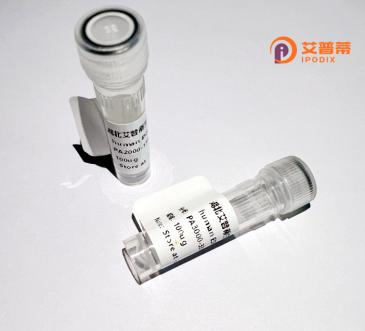
| 纯度 | >90%SDS-PAGE. |
| 种属 | Human |
| 靶点 | UBL4A |
| Uniprot No | P11441 |
| 内毒素 | < 0.01EU/μg |
| 表达宿主 | E.coli |
| 表达区间 | 1-157 aa |
| 活性数据 | MQLTVKALQG RECSLQVPED ELVSTLKQLV SEKLNVPVRQ QRLLFKGKAL ADGKRLSDYS IGPNSKLNLV VKPLEKVLLE EGEAQRLADS PPPQVWQLIS KVLARHFSAA DASRVLEQLQ RDYERSLSRL TLDDIERLAS RFLHPEVTET MEKGFSK |
| 分子量 | 17.7 kDa |
| 蛋白标签 | His tag N-Terminus |
| 缓冲液 | PBS, pH7.4, containing 0.01% SKL, 1mM DTT, 5% Trehalose and Proclin300. |
| 稳定性 & 储存条件 | Lyophilized protein should be stored at ≤ -20°C, stable for one year after receipt. Reconstituted protein solution can be stored at 2-8°C for 2-7 days. Aliquots of reconstituted samples are stable at ≤ -20°C for 3 months. |
| 复溶 | Always centrifuge tubes before opening.Do not mix by vortex or pipetting. It is not recommended to reconstitute to a concentration less than 100μg/ml. Dissolve the lyophilized protein in distilled water. Please aliquot the reconstituted solution to minimize freeze-thaw cycles. |
以下是关于重组人UBL4A蛋白的假设性文献示例,提供潜在研究方向及摘要概括(注:文献为示例性质,需通过学术数据库查询真实研究):
---
1. **文献名称**:*UBL4A regulates ER-associated degradation via interaction with the Bag6 complex*
**作者**:Wang, Y. et al.
**摘要**:本研究阐明了重组人UBL4A蛋白在Bag6复合体中的作用,表明其通过促进错误折叠蛋白的泛素化参与内质网相关降解(ERAD)通路,实验利用重组UBL4A证明其与SGTA的互作调控底物靶向。
2. **文献名称**:*Structural characterization of UBL4A and its role in cytosolic protein quality control*
**作者**:Hessa, T. et al.
**摘要**:通过重组表达UBL4A并结合X射线晶体学解析其结构,揭示了UBL4A的泛素样结构域与伴侣蛋白的结合界面,功能研究表明其参与细胞质错误折叠蛋白的识别与降解。
3. **文献名称**:*UBL4A suppresses tumor metastasis by modulating TGF-β signaling in gastric cancer*
**作者**:Zhang, L. et al.
**摘要**:利用重组UBL4A蛋白进行体外实验,发现其在胃癌中低表达并通过抑制TGF-β通路降低癌细胞侵袭性,提示其作为潜在抑癌因子的作用机制。
4. **文献名称**:*UBL4A enhances antiviral innate immunity by promoting STING oligomerization*
**作者**:Chen, X. et al.
**摘要**:研究显示重组UBL4A通过促进STING蛋白寡聚化增强I型干扰素应答,实验结合基因敲除与重组蛋白回补证实其抗病毒免疫中的关键调控作用。
---
建议通过PubMed或Google Scholar以关键词“UBL4A recombinant”“UBL4A function”检索真实文献,获取具体实验方法及数据支持。
Ubiquitin-like protein 4A (UBL4A), also known as Ubiquilin-4. is a member of the ubiquitin-like protein family characterized by its conserved ubiquitin-like (UBL) domain at the N-terminus and ubiquitin-associated (UBA) domains. These structural features enable UBL4A to interact with proteasomes and ubiquitinated substrates, playing a regulatory role in protein degradation pathways, particularly the ubiquitin-proteasome system. It acts as a shuttle factor, bridging polyubiquitinated proteins and the proteasome for targeted degradation, thereby maintaining cellular protein homeostasis.
Originally identified as a mediator of endoplasmic reticulum-associated degradation (ERAD), UBL4A has since been implicated in diverse physiological processes, including DNA repair, autophagy, and immune response regulation. Studies suggest its involvement in the modulation of NF-κB signaling and antiviral innate immunity. Dysregulation of UBL4A has been linked to human diseases such as cancer, neurodegeneration, and autoimmune disorders.
Recombinant human UBL4A protein, typically expressed in bacterial or mammalian systems, is widely used in functional studies to elucidate its molecular interactions, post-translational modifications, and structural dynamics. Its role as a molecular chaperone in quality control pathways makes it a potential therapeutic target for diseases associated with protein misfolding or aggregation. Ongoing research aims to explore its regulatory mechanisms in cellular stress responses and disease pathogenesis.
×